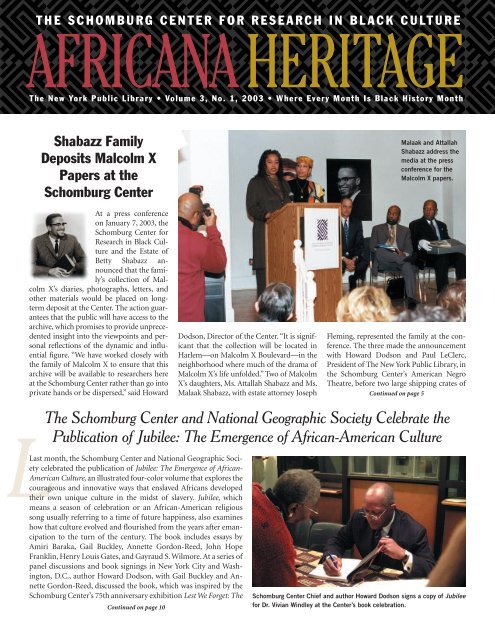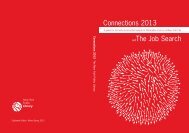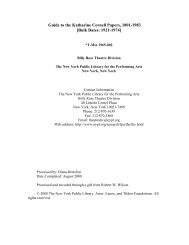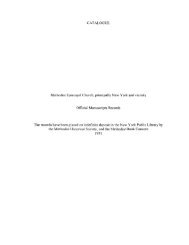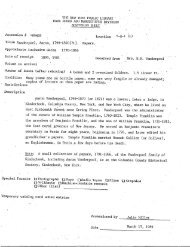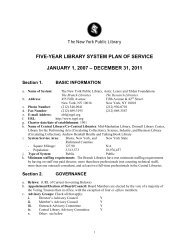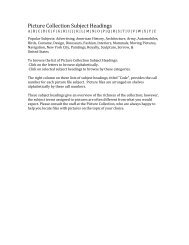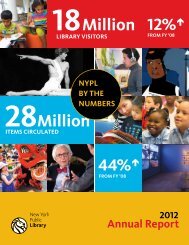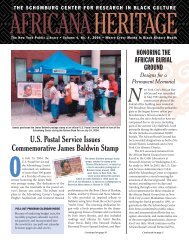Volume 3, #1 - New York Public Library
Volume 3, #1 - New York Public Library
Volume 3, #1 - New York Public Library
You also want an ePaper? Increase the reach of your titles
YUMPU automatically turns print PDFs into web optimized ePapers that Google loves.
T H E S C H O M B U R G C E N T E R F O R R E S E A R C H I N B L A C K C U LT U R E<br />
AFRICANA HERITAGE<br />
The <strong>New</strong> <strong>York</strong> <strong>Public</strong> <strong>Library</strong> • <strong>Volume</strong> 3, No. 1, 2003 • Where Every Month Is Black History Month<br />
Shabazz Family<br />
Deposits Malcolm X<br />
Papers at the<br />
Schomburg Center<br />
At a press conference<br />
on January 7, 2003, the<br />
Schomburg Center for<br />
Research in Black Culture<br />
and the Estate of<br />
Betty Shabazz announced<br />
that the family’s<br />
collection of Malcolm<br />
X’s diaries, photographs, letters, and<br />
other materials would be placed on longterm<br />
deposit at the Center. The action guarantees<br />
that the public will have access to the<br />
archive, which promises to provide unprecedented<br />
insight into the viewpoints and personal<br />
reflections of the dynamic and influential<br />
figure. “We have worked closely with<br />
the family of Malcolm X to ensure that this<br />
archive will be available to researchers here<br />
at the Schomburg Center rather than go into<br />
private hands or be dispersed,” said Howard<br />
Dodson, Director of the Center. “It is significant<br />
that the collection will be located in<br />
Harlem—on Malcolm X Boulevard—in the<br />
neighborhood where much of the drama of<br />
Malcolm X’s life unfolded.” Two of Malcolm<br />
X’s daughters, Ms. Attallah Shabazz and Ms.<br />
Malaak Shabazz, with estate attorney Joseph<br />
Malaak and Attallah<br />
Shabazz address the<br />
media at the press<br />
conference for the<br />
Malcolm X papers.<br />
Fleming, represented the family at the conference.<br />
The three made the announcement<br />
with Howard Dodson and Paul LeClerc,<br />
President of The <strong>New</strong> <strong>York</strong> <strong>Public</strong> <strong>Library</strong>, in<br />
the Schomburg Center’s American Negro<br />
Theatre, before two large shipping crates of<br />
Continued on page 5<br />
L<br />
The Schomburg Center and National Geographic Society Celebrate the<br />
<strong>Public</strong>ation of Jubilee: The Emergence of African-American Culture<br />
Last month, the Schomburg Center and National Geographic Society<br />
celebrated the publication of Jubilee: The Emergence of African-<br />
American Culture, an illustrated four-color volume that explores the<br />
courageous and innovative ways that enslaved Africans developed<br />
their own unique culture in the midst of slavery. Jubilee, which<br />
means a season of celebration or an African-American religious<br />
song usually referring to a time of future happiness, also examines<br />
how that culture evolved and flourished from the years after emancipation<br />
to the turn of the century. The book includes essays by<br />
Amiri Baraka, Gail Buckley, Annette Gordon-Reed, John Hope<br />
Franklin, Henry Louis Gates, and Gayraud S. Wilmore. At a series of<br />
panel discussions and book signings in <strong>New</strong> <strong>York</strong> City and Washington,<br />
D.C., author Howard Dodson, with Gail Buckley and Annette<br />
Gordon-Reed, discussed the book, which was inspired by the<br />
Schomburg Center’s 75th anniversary exhibition Lest We Forget: The<br />
Continued on page 10<br />
Schomburg Center Chief and author Howard Dodson signs a copy of Jubilee<br />
for Dr. Vivian Windley at the Center’s book celebration.
FROM THE CHIEF<br />
By now you have undoubtedly heard that the<br />
extraordinary archive of Malcolm X’s speeches,<br />
correspondence, photographs, scripts for<br />
radio programs, diaries, and other memorabilia<br />
are no longer in the auctioneer’s hands. A year or<br />
so ago, it had been posted on eBay, the auction house<br />
Web site on the Internet, and was slated for sale in lots<br />
to the highest bidder. Protests from around the country<br />
coupled with a series of legal maneuvers by the<br />
lawyers for the Betty Shabazz/Malcolm X Estate cancelled<br />
the auction. And over the past year, negotiations<br />
between the Shabazz Family Estate, the auction house,<br />
and other interested parties resulted in a decision to<br />
return all of the materials to the Shabazz family, the<br />
rightful owners. The family in turn decided to make<br />
the Schomburg Center the repository of this unique<br />
collection on the life, times, and legacy of Malcolm X.<br />
The collection arrived in December and is currently<br />
being inventoried by members of the Schomburg Center<br />
staff. Processing and preservation work will take<br />
Your ongoing financial support continues to be a<br />
major source of inspiration, encouragement, and<br />
sorely needed revenue. I hope we can continue to<br />
count on your commitment and support.<br />
– Howard Dodson, Schomburg Chief<br />
place over the next eighteen months or so, and the collection<br />
will be opened to the public in July 2004. A<br />
major Malcolm X exhibition based on materials in the<br />
collection is slated for May 2004.<br />
Those of you who missed this year’s production<br />
of Nativity: A Life Story missed a major <strong>New</strong> <strong>York</strong> City<br />
cultural event. Inspired by Langston Hughes’s Black<br />
Nativity, Nativity featured such luminaries as BeBe<br />
Winans, Stephanie Mills, Phylicia Rashad, Freddie<br />
Jackson, Lillias White, and Ebony Jo-Ann to mention<br />
only a few. After four years at the Center and one year<br />
at <strong>New</strong> <strong>York</strong>’s Riverside Church (where it sold out last<br />
year), we decided to move it to Reverend Ike’s United<br />
Palace, a 3,500-seat venue on Broadway at 175th<br />
Street. Three sold out magnificent performances attracted<br />
more than 9,000 paying customers from cities<br />
as far away as Baltimore, Washington, Providence, and<br />
Boston. It was spectacular. Ten shows are planned for<br />
this year beginning on December 2. Tickets will go on<br />
sale soon.<br />
Jubilee: The Emergence of African-American Culture,<br />
a new Schomburg Center publication, was recently<br />
released by National Geographic Press. Based<br />
on the Schomburg’s exhibition Lest We Forget: The Triumph<br />
Over Slavery, Jubilee was written by yours truly<br />
with essays by John Hope Franklin, Henry Louis<br />
Gates, Annette Gordon-Reed, Gail Buckley, Gayraud S.<br />
Wilmore, and Amiri Baraka. Some 200 photographs,<br />
prints, documents, and other memorabilia judiciously<br />
designed and edited by National Geographic Press<br />
make Jubilee an attractive, accessible, and informative<br />
resource on two of the most significant aspects of<br />
American and African-American history and culture.<br />
A national conference on the State of Black Studies,<br />
co-sponsored by Princeton University’s African<br />
American Studies Program and CUNY’s Graduate<br />
Center and Institute for Research on<br />
the African Diaspora in the Americas<br />
and the Caribbean (IRADAC)<br />
featured some of the leading authorities<br />
in the field and attracted<br />
over 600 participants from across<br />
the country—one of the largest<br />
such gatherings in recent memory.<br />
More detailed coverage of the conference<br />
will appear in the next issue<br />
of Africana Heritage.<br />
The success of the last quarter or so notwithstanding,<br />
storm clouds have appeared on the horizon<br />
posing threats to the quality and quantity of programs<br />
and services the Center will be able to offer in the<br />
coming months and years. Proposed cuts to the City<br />
and State of <strong>New</strong> <strong>York</strong>’s annual appropriations to the<br />
Center make it likely that we will have to limit our<br />
schedule to four days of research services weekly.<br />
(We’re already down to five.) Under-performing endowments<br />
make it likely that we’ll also have to reduce<br />
the number of educational and cultural programs and<br />
exhibitions we offer. Your ongoing financial support<br />
continues to be a major source of inspiration, encouragement,<br />
and sorely needed revenue. I hope we can<br />
continue to count on your commitment and support.<br />
2 Africana Heritage • <strong>Volume</strong> 3, No. 1, 2003 • Where Every Month Is Black History Month
Junior Scholars Prepare for Youth Summit<br />
The <strong>New</strong> <strong>York</strong> Life/Schomburg Center Junior<br />
Scholars Program continues to provide<br />
a forum for young people to embark on<br />
content rich study at the Schomburg Center<br />
for Research in Black Culture each Saturday.<br />
In their ongoing academic pursuits, the Junior<br />
Scholars conduct in-depth research<br />
within the various divisions of the Schomburg<br />
and incorporate the words and ideas of<br />
living legends and of visiting scholars into<br />
the creation of original works. The Junior<br />
Scholars Program is hosting Youth Summit:<br />
From Violence to Peace on May 17 for Junior<br />
Scholars and invited youth to present historically-based<br />
works addressing the theme<br />
of the Youth Summit in theater, photography,<br />
video, spoken word, music, and dance.<br />
During interactive workshops over the<br />
last several months, The Junior Scholars<br />
have been exposed to a myriad of exhibitions,<br />
forums, and performances at the<br />
Schomburg Center. Center Chief Howard<br />
Dodson was one of the first historians to<br />
Above, Earl Graves, George Faison, Hon. C. Virginia Fields, and Billy Taylor with scholars at the award<br />
ceremony for The 2003 Top Faces of Black History, hosted by the Schomburg Center, McDonald’s<br />
<strong>New</strong> <strong>York</strong> Metro Owners and Operators, The <strong>New</strong> <strong>York</strong> Knicks, and The <strong>New</strong> <strong>York</strong> Liberty.<br />
Enhancing self-esteem<br />
through African-American<br />
history and culture.<br />
Scholars Tarik Bell and Nafia Williams at a<br />
sculpture workshop.<br />
Above, Scholar Khaveev Benaiah asks a question<br />
of the WRKS-FM/McDonald's Open Line panel;<br />
the panel discussed U.S. involvement in Iraq.<br />
Right, Dr. Maulana Karenga speaks to scholars.<br />
share his insights and analyses of the<br />
African-American experience with the Junior<br />
Scholars. In the fall, scholars investigated<br />
the complex history of Jim Crow with art<br />
historian Dr. Gwendolyn H. Everett, curator<br />
of The <strong>New</strong> <strong>York</strong> Life exhibit Rising Above<br />
Jim Crow: The Paintings of Johnnie Lee Gray,<br />
which was on display at the Center until early<br />
January. The scholars continued their<br />
study of art history, exploring the work of<br />
women artists from North, West, and South<br />
Africa in the Schomburg Center’s Art of<br />
African Women: Empowering Traditions exhibition<br />
and participating in workshops led<br />
by photographer Margaret Courtney-<br />
Clarke and South African students Duduzile<br />
Mahlangu and Nomsa Masanabo. Since the<br />
program year began, Junior Scholars have<br />
also viewed Amandla!: A Revolution in Four<br />
Part Harmony and the PBS/P.O.V. film “Two<br />
Towns of Jasper”; welcomed talks by Percy<br />
Sutton, Terrie Williams, and noted college<br />
professor Dr. Maulana Karenga, among others;<br />
attended the WRKS-FM/McDonald’s<br />
Open Line Show and Lincoln Center’s Reel<br />
to Real: A Tribute to Cab Calloway; toured<br />
the American Museum of Natural History<br />
and the Hall of Science; and participated in<br />
Carnegie Hall’s Neighborhood Concert Series.<br />
The individual interests and needs of<br />
students are addressed through an entrepreneurship<br />
and banking module for students<br />
seeking business knowledge. Students<br />
will learn from leaders in finance and from<br />
successful business owners about the basics<br />
and intricacies of starting, financing, and<br />
managing a business. Moody’s Corporation<br />
sponsors this endeavor.<br />
Junior Scholars with an interest in the<br />
arts have learned about sculpture and created<br />
works in stone and plaster with sculptor<br />
M. Scott Johnson; studied painting with<br />
Ndebele students; learned Web site design<br />
from Webmaster Donald Olivier; and participated<br />
in hands-on filmmaking with<br />
business owner and videographer Mishka<br />
Brown of Aerolith Incorporated.<br />
The skills developed in the Junior<br />
Scholars Program are directly transferable<br />
both to the successful completion of projects<br />
for the Youth Summit and to the students’<br />
daily school environments. Overall,<br />
the program enhances self-esteem by allowing<br />
students to deepen their understanding<br />
of their African-American history and culture<br />
and to obtain up-to-date experiences<br />
in contemporary fields.<br />
Please visit us at www.juniorscholars.org<br />
and register to attend the Youth<br />
Summit on May 17!<br />
Africana Heritage • <strong>Volume</strong> 3, No. 1, 2003 • Where Every Month Is Black History Month 3
H E R I TA G E WATCH<br />
The Malcolm X Collection: A Preview<br />
The Schomburg Center’s Manuscripts,<br />
Archives and Rare Books Division staff, under<br />
the leadership of the curator, has undertaken<br />
an enormous task in archiving the Malcolm X<br />
Collection, deposited at the Center on a seventy-five-year<br />
loan. The collection arrived in<br />
late December and by January the inventory<br />
was under way. Each Division staff member<br />
will continue the painstaking inventory<br />
through the summer. Once the inventory is<br />
completed the actual work of organizing the<br />
collection for research will begin. The collection<br />
will then be microfilmed. The Center anticipates<br />
that The Malcolm X Collection will<br />
be available to researchers by July 2004. The<br />
Malcolm X Collection: A Preview is an advance<br />
look at this extraordinary archive.<br />
B<br />
Born Malcolm Little on May 19, 1925, in<br />
Omaha, Nebraska, Malcolm X became one<br />
of the world’s most prominent leaders in the<br />
twentieth-century movement for black liberation<br />
in the United States and Africa. His<br />
life and work were cut short on February 21,<br />
1965, when he was assassinated at the<br />
Audubon Ballroom in Harlem.<br />
In January 2003 a large collection of<br />
Malcolm X’s diaries, photos, letters, and<br />
other materials were placed on long-term<br />
deposit by the Estate of Betty Shabazz, at<br />
The <strong>New</strong> <strong>York</strong> <strong>Public</strong> <strong>Library</strong>’s Schomburg<br />
Center for Research in Black Culture. The<br />
materials include a wide range of speeches,<br />
letters, diaries, and other documents handwritten<br />
or typed by Malcolm X; a collection<br />
of photographs, many of which are presumed<br />
to have been taken by Malcolm X,<br />
and others that show various aspects of his<br />
life, including pictures of him with his family<br />
and with dignitaries; handwritten radio<br />
addresses delivered to spread the message of<br />
Elijah Muhammad’s Nation of Islam; many<br />
outlines and manuscripts for speeches given<br />
at rallies and other public appearances; and<br />
the manuscript outline of his speech “The<br />
Ballot or the Bullet,” in which he revised his<br />
message to encourage the black community<br />
1.<br />
2. 3.<br />
4.<br />
to flex its political muscle through voting.<br />
The materials provide unprecedented<br />
insight into the viewpoints and personal reflections<br />
of the dynamic and vastly influential<br />
figure who spearheaded a vigorous fight<br />
for the rights of African Americans in the<br />
1960s, through his work with the Nation of<br />
Islam and later his own Organization of<br />
Afro-American Unity. The availability of<br />
these papers promises to provide new insights<br />
into the depth, breadth, and complexity<br />
of his life and work.<br />
4 Africana Heritage • <strong>Volume</strong> 3, No. 1, 2003 • Where Every Month Is Black History Month
5.<br />
7.<br />
6.<br />
1. Family photos, including<br />
(right) Malcolm X and wife<br />
Betty Shabazz, with daughters<br />
(left to right: Attallah, Quibilah,<br />
and Ilyasah) are seated<br />
with Muhammad Ali (known<br />
then as Cassius Clay) at Ali’s<br />
Miami training camp. February<br />
1964. The visit, which was<br />
the family’s first vacation, occurred<br />
during the ninety-day<br />
suspension of Malcolm X from<br />
the Nation of Islam. Photographer:<br />
Robert L. Haggins.<br />
2. Left, Letter to brother<br />
Philbert, February 4, 1949.<br />
Signed “Your Brother Malcolm.”<br />
Three pages. Right,<br />
Letter to brother Philbert,<br />
January 29, 1950. Signed<br />
“Your Brother Malcolm X.”<br />
Four pages.<br />
3. Record Album. “Ballots or<br />
Bullets” by Malcolm X, recorded<br />
in 1963 at King Solomon<br />
Baptist Church, Detroit, Michigan.<br />
First Amendment<br />
Records.<br />
4. Photographs of Malcolm<br />
X's international travels.<br />
5. Record Album.<br />
Message to the Grass Roots<br />
from Malcolm X. Afro-American<br />
Broadcasting & Recording<br />
Company, Detroit, Michigan,<br />
1965.<br />
6. Media photographs, including<br />
(right) Malcolm X with<br />
television reporter Gabe Pressman<br />
at Harlem rally, ca.<br />
1963. Photographer: Robert L.<br />
Haggins.<br />
7. Journal. Handwritten details<br />
of journey to Mecca, including<br />
entry dated April 18,<br />
1964, in which he writes, “It<br />
was strange to be referred to<br />
now as Malcolm X, so boldly<br />
and openly, after several days<br />
going only as Malik El<br />
Shabazz.”<br />
Malcolm X, continued from page 1<br />
materials from the collection.<br />
Since January, curators and library<br />
staff have unpacked and inventoried<br />
an array of speeches, letters,<br />
diaries, and other documents by<br />
Malcolm X. In addition to these rich<br />
documents, the archive consists of<br />
many photographs of Malcolm X,<br />
family members, Elijah Muhammad,<br />
other Nation of Islam leaders, and<br />
personalities such as Muhammad Ali.<br />
There are also some sixty-seven<br />
handwritten radio addresses delivered<br />
to spread the message of Elijah<br />
Muhammad’s Nation of Islam. The<br />
collection includes manuscripts for<br />
Malcolm X’s speeches, including a<br />
manuscript outline of “The Ballot or<br />
the Bullet,” as well as a contract and<br />
correspondence between Malcolm X<br />
and Alex Haley regarding The Autobiography<br />
of Malcolm X.<br />
Some of the most notable pieces<br />
in the collection include handwritten<br />
diaries Malcolm X kept during his<br />
travels to Africa and the Middle East.<br />
These notes, taken shortly after he<br />
broke from the Nation of Islam in<br />
1964, were not fully explored in The<br />
Autobiography of Malcolm X, nor has<br />
this period been completely examined<br />
and researched in written histories<br />
or scholarship. The diaries, as well<br />
as other pieces in the collection,<br />
should illuminate the enormous<br />
legacy of Malcolm X in vital and important<br />
ways.<br />
The Shabazz family will retain<br />
ownership of the collection, which<br />
had been the subject of conflicting<br />
claims since Butterfields Auctioneers<br />
announced that it would offer the<br />
materials for sale last March. After negotiations<br />
the property was returned<br />
to the family, which decided to deposit<br />
the collection at the Schomburg<br />
Center where it will be cataloged, preserved,<br />
and stored for a period of seventy-five<br />
years. While processing and<br />
preservation of the materials will take<br />
approximately eighteen months, the<br />
Center launched The Malcolm X Collection:<br />
A Preview in February (at<br />
left). Its intention is to provide a<br />
glimpse of what President LeClerc<br />
called “one of the single most important<br />
collections to come to The <strong>New</strong><br />
<strong>York</strong> <strong>Public</strong> <strong>Library</strong> in the last<br />
decade.” The cameo exhibition is on<br />
view through May 2003.<br />
Africana Heritage • <strong>Volume</strong> 3, No. 1, 2003 • Where Every Month Is Black History Month 5
A R O U N D T H E<br />
S C H O M B U R G C E N T E R<br />
Kaissa (and<br />
friends) at the<br />
Schomburg<br />
Center’s Heritage<br />
Weekend 2003.<br />
Eleanor Leinen leads hands-on classes in gift<br />
wrapping at Holiday Open House.<br />
The Brewery<br />
Puppetry<br />
Troupe’s The<br />
Crowtations<br />
perform at the<br />
Center’s annual<br />
Holiday Open<br />
House in<br />
December.<br />
<strong>New</strong> <strong>York</strong> City Mayor Mike Bloomberg announces<br />
the city’s new school policy at a <strong>New</strong> <strong>York</strong> Urban<br />
League symposium at the Schomburg Center.<br />
Gail Buckley,<br />
Annette Gordon-<br />
Reed, and<br />
Howard Dodson<br />
discuss Jubilee:<br />
The Emergence<br />
of African-<br />
American<br />
Culture.<br />
RENTAL SERVICES AVAILABLE<br />
In addition to our collections, the<br />
Schomburg Center has an active<br />
rental service. The beautiful facilities<br />
are professionally equipped<br />
and can accommodate a wide<br />
range of special events sponsored<br />
by organizations and institutions,<br />
from concerts, music, theater,<br />
and receptions to educational<br />
seminars and conferences at<br />
competitive market based rental<br />
rates. Call (212) 491-2257 for<br />
rates and information.<br />
6 Africana Heritage • <strong>Volume</strong> 3, No. 1, 2003 • Where Every Month Is Black History Month
Kofi and Nane Annan in front of the<br />
Schomburg Center after a visit to<br />
The Art of African Women:<br />
Empowering Traditions exhibition.<br />
McDonald’s <strong>New</strong> <strong>York</strong> Metro Owners and Operators, The <strong>New</strong> <strong>York</strong> Knicks, and The <strong>New</strong> <strong>York</strong> Liberty brought The<br />
2003 Top Faces of Black History to the Schomburg Center on February 1. Seated, Cissy Houston, Bishop Kenneth<br />
Moales, Basil Paterson, Billy Taylor, Katherine Dunham, and Dionne Warwick. Standing, James Henderson, Earl<br />
Graves, Floyd Flake, Jeff Burns, George Faison, Hon. C. Virginia Fields, Teresa Weatherspoon, and Hezekiah Walker.<br />
<strong>New</strong> <strong>York</strong> Dance Divas captivated a sold-out house on February 14, 2003. The event featured a special guest appearance by dance legend Katherine Dunham.<br />
Johnnetta B. Cole and Beverly Guy-Sheftall sign copies of<br />
Gender Talk at their book celebration in February.<br />
Howard Dodson, William Strickland, and Maulana Karenga at the plenary session<br />
“Black Studies: The Long Road Since the 1960s.” The session was part of The<br />
State of Black Studies: Methodology, Pedagogy, and Research, a conference at the<br />
Schomburg Center and CUNY’s Graduate Center.<br />
Africana Heritage • <strong>Volume</strong> 3, No. 1, 2003 • Where Every Month Is Black History Month 7
NEWFROM THE SCHOMBURG CENTER<br />
Totebag with Zipper and Beaded Strip<br />
SKU9000020433<br />
$65<br />
Beaded Necklace<br />
with Bracelet<br />
SKU9000020247<br />
$25<br />
Painted Calabash/Painted<br />
and Beaded Calabash<br />
(sizes and shapes vary)<br />
SKU9000020166<br />
$40 – $65<br />
Necklace<br />
with Doll<br />
SKU9000020174<br />
$6<br />
Beaded Pillow<br />
18 X 18, with One<br />
Beaded Strip<br />
18 X 18, with Two Strips<br />
24 X 24, Fully Beaded<br />
24 X 24, Two Strips<br />
SKU9000020468<br />
$125 – $495<br />
Featuring The Art of African Women: Empowering Traditions<br />
P R O D U C T S F R O M T H E S C H O M B U R G S H O P<br />
In October 2002, the Center launched The Art of African<br />
Women: Empowering Traditions, an unprecedented<br />
exhibition of more than 100 photographs by<br />
photographer Margaret Courtney-Clarke. On<br />
view through May 2003, the exhibition pays<br />
tribute to African women’s artistic traditions<br />
and to the beauty that rural African<br />
women—as artists and entrepreneurs—create<br />
in the face of ongoing social, political,<br />
and economic challenges, disruption, and<br />
upheaval. From October 28 through November<br />
15, 2002, the Center welcomed Ndebele<br />
Cultural Centre master artists Francina Ndala<br />
Ndimande and Angelina Ndimande, students<br />
Duduzile Mahlangu and Nomsa Masanabo, and staff,<br />
Deon DeLange and Marry-Ann Tjale, to the Center. The<br />
group lived in Harlem, toured <strong>New</strong> <strong>York</strong> City, worked<br />
Beaded Ostrich Egg<br />
SKU9000019648<br />
$60<br />
with the Schomburg Center Junior Scholars and other<br />
artists, produced original pieces of artwork for The<br />
Schomburg Shop, and created an original mural,<br />
especially commissioned for the exhibition. The<br />
Art of African Women presented the Schomburg<br />
Center with the opportunity to feature<br />
the astonishing art of these women and to offer<br />
unique items created by Ndebele artists to<br />
the general public. The items shown here represent<br />
a small percentage of the beautiful artwork<br />
handcrafted by The Ndebele Foundation<br />
and Cultural Centre for Women and Children in<br />
South Africa. All these products are available by<br />
calling The Schomburg Shop at (212) 491-2206. By<br />
giving a unique gift from the Ndebele Cultural Centre<br />
Foundation, you will also be helping to support the<br />
women who create these important pieces of artwork.<br />
8 Africana Heritage • <strong>Volume</strong> 3, No. 1, 2003 • Where Every Month Is Black History Month
Jubilee: The Emergence of<br />
African-American Culture<br />
Howard Dodson,<br />
Amiri Baraka, John<br />
Hope Franklin,<br />
Gail Buckley, Henry<br />
Louis Gates, Jr.,<br />
Annette Gordon-<br />
Reed, and Gayraud<br />
S. Wilmore.<br />
Hardcover, 224<br />
pages, $35.<br />
Gender Talk<br />
The Struggle for<br />
Women’s Equality in<br />
African American<br />
Communities<br />
Johnnetta B. Cole and<br />
Beverly Guy-Sheftall.<br />
Hardcover, 298 pages,<br />
$24.95.<br />
E X H I B I T I O N S<br />
The Art of African Women:<br />
Empowering Traditions<br />
Through May 2003<br />
The Art of African Women: Empowering<br />
Traditions exhibition presents an unprecedented<br />
survey of African artistic traditions<br />
that have been passed down from mothers<br />
to daughters for centuries. The exhibition<br />
features more than 100 stunning photographs<br />
by internationally acclaimed<br />
photojournalist Margaret Courtney-<br />
Clarke. Captured during her twenty-year<br />
quest to document traditions in South,<br />
West, and North Africa, the images pay<br />
homage to the beauty African women<br />
have created in their lives despite social,<br />
political, and economic upheavals. The<br />
photographs are complemented by more<br />
than thirty objects, many of which have<br />
been photographed with their creators.<br />
The multidimensional exhibition includes<br />
an interactive children’s exhibit designed<br />
to expose and involve young people in the<br />
creation of traditional arts and a public<br />
program series intended to survey critical<br />
social issues as well as the roles of African<br />
women as creators and entrepreneurs.<br />
Harlem Is…<br />
Through August 2003<br />
Community Works, in association with the<br />
<strong>New</strong> Heritage Theatre Group and the<br />
Schomburg Center, presents a multimedia,<br />
intergenerational, living history program<br />
that celebrates<br />
thirty<br />
Harlemites<br />
(ages fifty to<br />
100) whose<br />
contributions<br />
in the fields<br />
of art, music,<br />
education,<br />
politics, community<br />
service,<br />
and<br />
sports define<br />
Harlem’s rich<br />
and diverse cultural legacy. Harlem Is…<br />
honors such trailblazers as opera singer<br />
Betty Allen, historian Dr. Yosef ben-<br />
Jachannan, Afro-Latin jazz musician Joe<br />
Cuba, author Rosa Guy, and many more.<br />
Community Works will present performances,<br />
symposiums, group tours, workshops,<br />
and tours of the community.<br />
The Malcolm X Collection:<br />
A Preview<br />
Through May 2003<br />
In January 2003 a large collection of Malcolm<br />
X’s diaries, photographs, letters, and<br />
other materials were placed on long-term<br />
deposit by the Estate of Betty Shabazz at the<br />
Schomburg Center for Research in Black<br />
Culture. While the papers will be available<br />
to researchers after approximately eighteen<br />
months of processing and preservation<br />
work is completed, The Malcolm X Collection:<br />
A Preview offers a glimpse into the<br />
viewpoints and personal reflections of the<br />
dynamic and vastly influential figure who<br />
spearheaded a vigorous fight for the rights<br />
of African Americans in the 1960s.<br />
Schomburg Center programs and exhibitions<br />
are supported in part by the City of <strong>New</strong> <strong>York</strong>,<br />
the State of <strong>New</strong> <strong>York</strong>, the Office of the Borough<br />
President of Manhattan, the <strong>New</strong> <strong>York</strong><br />
State Black, Puerto Rican and Hispanic Legislative<br />
Caucus, the Rockefeller Foundation<br />
Endowment for the Performing Arts, The<br />
Coca-Cola Foundation, <strong>New</strong> <strong>York</strong> Life Foundation,<br />
Annie E. and Sarah L. Delaney Charitable<br />
Trusts, J.P. Morgan Chase & Co., and<br />
the Edler Hawkins Foundation.<br />
The Schomburg Center is a member of the<br />
Harlem Strategic Cultural Collaborative<br />
(HSCC).<br />
PLANNED GIVING NOTE<br />
Unless you leave your IRA or pension<br />
plan to a spouse, it can be taxed<br />
heavily in your estate. If your estate<br />
is over $1 million, these funds can<br />
be subject to both estate and income<br />
tax, which may total over 80 percent.<br />
This leaves your family or other<br />
heirs a mere 20 percent of a lifetime<br />
of savings.<br />
If you are not leaving your IRA<br />
or pension plan to a spouse, it may<br />
make sense to name the Schomburg<br />
Center as beneficiary of your plan.<br />
You can avoid completely income<br />
and estate taxes on these funds, thus<br />
enabling you to leave more of your<br />
other assets to your heirs. And you<br />
can make a meaningful gift to the<br />
Schomburg Center as part of your<br />
legacy. For more information, please<br />
contact Randy V. Beranek, Manager<br />
of Planned Giving, (212) 930-0568.<br />
Email: plannedgifts@nypl.org.<br />
Africana Heritage • <strong>Volume</strong> 3, No. 1, 2003 • Where Every Month Is Black History Month 9
JUBILEE, continued from page 1<br />
Triumph Over Slavery.<br />
The Schomburg Center and National<br />
Geographic Society launched the series of<br />
panel discussions at the Center in early February.<br />
The book celebrations and discussions,<br />
at the Schomburg Center and Barnes<br />
& Noble Union Square, began with a thorough<br />
and engaging introduction by Howard<br />
Dodson and included commentary on<br />
African-American military service and family<br />
life by Gail Buckley and Annette Gordon-<br />
Reed. C-SPAN’s “History on Book TV”<br />
aired the Schomburg Center talk Saturday,<br />
March 15, and Sunday, March 16. The<br />
Washington panel, which also featured<br />
Dodson, Buckley, and Gordon-Reed, took<br />
place at National Geographic Society’s Explorers<br />
Hall, where a version of the Schomburg<br />
Center’s Lest We Forget exhibition was<br />
mounted for the occasion. The exhibit was<br />
on view in Washington until March 5.<br />
Since the publication of Jubilee in February,<br />
Howard Dodson has been speaking<br />
around the country about the volume,<br />
which was hailed by Publishers Weekly as “an<br />
explosive, necessary book.” Earlier this year,<br />
Howard Dodson spoke about Jubilee with<br />
Ingram Book Company editor Amy Cox<br />
Williams. Their conversation follows.<br />
Jubilee Celebrates<br />
African-American Culture<br />
by Amy Cox Williams, Catalog Editor,<br />
Ingram Book Company<br />
In February, National Geographic published a<br />
truly unique book celebrating the development<br />
and emergence of African-American culture<br />
out of the bonds of slavery. Jubilee is written by<br />
Howard Dodson, Chief of the Schomburg<br />
Center for Research in Black Culture, with essays<br />
by leading African-American voices, including<br />
Henry Louis Gates, Jr., John Hope<br />
Franklin, Amiri Baraka, Annette Gordon-<br />
Reed, and Gail Buckley. Richly illustrated with<br />
more than 200 items—from slave ship manifests<br />
to some of the earliest photographs of<br />
slaves to freedom quilts—culled from the<br />
Schomburg’s own collection, Jubilee offers<br />
readers a glimpse of African Americans’ transition<br />
from slavery to freedom. Howard Dodson<br />
recently took time from his busy schedule<br />
to talk to us at Ashanti about Jubilee.<br />
AMY COX WILLIAMS: Your book Jubilee offers<br />
readers a provocative new way to think<br />
about slavery and the slave trade. In the<br />
book, you write that it was in the context of<br />
slavery that enslaved Africans forged their<br />
own identity and laid the foundations of<br />
From Jubilee: The Emergence of African-American Culture (above left): Emancipation Proclamation.<br />
Manuscripts, Archives and Rare Books Division. (Above right): Poems on Various Subjects, Religious and<br />
Moral by Phillis Wheatley (ca. 1753-1784). Born in Africa and enslaved in America, Phillis Wheatley<br />
was the first published African-American author. Manuscripts, Archives and Rare Books Division.<br />
African-American culture throughout the<br />
Western Hemisphere. How did this idea<br />
evolve?<br />
HOWARD DODSON: My major area of concentration<br />
in my doctoral program was the<br />
comparative history of slavery. Throughout<br />
my formal study, I was uncomfortable with<br />
the idea that enslaved Africans were mere<br />
victims of slavery. Evidence clearly indicated<br />
that they were critically thinking human beings<br />
with visions, goals, and objectives that<br />
they continually pursued in search of their<br />
freedom and human dignity. Over the years,<br />
I have continued to explore the subject of<br />
human agency among enslaved African populations<br />
as a way of understanding them as<br />
history- and culture-makers.<br />
ACW: In the Introduction, you make mention<br />
of interesting and compelling facts<br />
about the American past that have mostly<br />
been unavailable to the American public.<br />
What are some of these facts and why have<br />
they been kept from the public?<br />
HD: Certainly one of the most remarkable<br />
facts about the American past (hemispheric)<br />
is that 5.5 million of the first 6.5 million<br />
migrants to the Americas prior to 1776<br />
were Africans. Equally significant is the fact<br />
that only 450,000 to 500,000 of the 10 million<br />
Africans who survived the Middle Passage<br />
and settled in the Americas actually<br />
came to the United States. The overwhelming<br />
majority went to Brazil and the islands<br />
of the Caribbean. Until recently, there has<br />
been little interest in learning or teaching<br />
anything about slavery.<br />
ACW: Jubilee is based on an exhibition organized<br />
by the Schomburg Center as part of its<br />
75th anniversary in 2000-2001 and most of<br />
the objects presented in the book are from<br />
the Schomburg Center’s collections. Can<br />
you talk about one or two of the more interesting<br />
pieces?<br />
HD: Two documents of freedom, The<br />
Emancipation Proclamation (1863) and<br />
the 13th Amendment Abolishing Slavery<br />
(1865) are included here because they collectively<br />
ended slavery in the United States.<br />
Phillis Wheatley’s Poems on Various Subjects<br />
(1st edition) is included because it is the<br />
first book of poetry published by an enslaved<br />
African in the United States. It is also<br />
the first literary work published by an<br />
African American.<br />
ACW: What makes this book rise above the<br />
fray of other slavery accounts?<br />
HD: Its focus on what enslaved Africans did<br />
to re-create themselves as human beings in<br />
the context of oppressive and exploitative<br />
systems of human bondage sets it apart<br />
from most general interpretations of slavery.<br />
It is also strengthened by the power of<br />
the visual iconography included in the text,<br />
as well as the essays by distinguished scholars<br />
of the black experience.<br />
ACW: What do you hope readers will take<br />
away from the experience of this book?<br />
HD: It is my hope that readers will come<br />
away from the book realizing that enslaved<br />
Africans were remarkable people who,<br />
through their own agency, transformed<br />
themselves into new people and reaffirmed<br />
their membership in the human family.<br />
Copyright © 2003 Ashanti Advance, the<br />
Ingram Book Magazine.<br />
10 Africana Heritage • <strong>Volume</strong> 3, No. 1, 2003 • Where Every Month Is Black History Month
Nativity: A Life Story<br />
<strong>New</strong> Major<br />
Campaign Gifts<br />
James Stovall, Hattie Winston, and Harold<br />
Wheeler have done it again! This year the<br />
crew wowed audiences with three heartstopping<br />
performances on Friday, December<br />
6, and Saturday, December 7, bringing<br />
their Christmas classic Nativity: A Life Story<br />
to almost 10,000 fans. The spirit and theme<br />
of Nativity 2002—Every Birth Is a Miracle—infused<br />
the historic United Palace<br />
Theatre, and through spoken word, song,<br />
and dance a cast of more than fifty artists<br />
gloriously told the story of the birth of Jesus<br />
through the eyes of his mother, Mary. Nativity<br />
2002 featured Stephanie Mills, BeBe<br />
Winans, Phylicia Rashad, Lillias White,<br />
Freddie Jackson, Keith David, Denise Burse-<br />
Fernandez, Alyson Williams, Ebony Jo-Ann,<br />
Priscilla Baskerville, Dwayne Grayman,<br />
George Faison, The Ebony Ecumenical Ensemble,<br />
The Broadway Inspirational Voices,<br />
The Christ United Church Youth-In-Action<br />
Chorus, and many more. Plans for Nativity<br />
2003 are underway, and it’s sure to be spectacular.<br />
Don’t miss what The <strong>New</strong> <strong>York</strong><br />
Times calls “...a great addition to the holiday<br />
season in <strong>New</strong> <strong>York</strong>. Spread the word.”<br />
GIFTS OF $200,000 TO $999,999<br />
Mr. & Mrs. Earl Graves<br />
GIFTS OF $50,000 TO $199,999<br />
Deutsche Bank Foundation<br />
Mr. & Mrs. Richard D. Parsons<br />
Schomburg Society<br />
Conservators<br />
The Schomburg Center is pleased<br />
to acknowledge the following<br />
donors of membership gifts of<br />
$1,000 or more from November<br />
2002 through February 2003.<br />
Clockwise from above left, BeBe Winans and Shirley Black Brown Coward perform “Mary Did You<br />
Know”; Ebony Jo-Ann and Stephanie Mills sing “Ordinary People”; Nyjah Moore Westbrooks,<br />
Dwayne Grayman, Brian Hawthorne, and Anika Ellis in “No Room”; and Keith David, Denise<br />
Burse-Fernandez, and Nativity cast.<br />
Mr. Joseph T. Anderer<br />
B. Blood<br />
Mr. Samuel C. Butler<br />
Dr. Johnnetta B. Cole<br />
Ms. Carol Cooper<br />
Dr. Camille Cosby<br />
Mr. David William Dunlap<br />
Ms. Carolyn A. Greene<br />
Mr. Mannie L. Jackson<br />
Mr. Vernon Jordan<br />
Mr. William M. Lewis, Jr. &<br />
Ms. Carol Sutton Lewis<br />
Ms. Andrea Mason<br />
Mr. Mark McEwen<br />
Dr. Benjamin F. Payton<br />
Mr. Marion A. Piggee, Jr.<br />
Mr. Robert H. Preiskel<br />
Raymond W. Ransom, MD<br />
Ms. Phyllis G. Roe<br />
Mr. & Mrs. Jim Simons<br />
Mr. George B. Simpson<br />
Dr. Leonard Weather, Jr.<br />
Claudia & Aubrey Woods<br />
Colonel & Mrs. James E. Williams<br />
AFRICANA HERITAGE<br />
2003 <strong>Volume</strong> 3, Number 1<br />
Africana Heritage is a quarterly publication of the Schomburg<br />
Center for Research in Black Culture for members who<br />
contribute $35 or more annually. The Schomburg Center is<br />
one of the Research Libraries of The <strong>New</strong> <strong>York</strong> <strong>Public</strong> <strong>Library</strong>,<br />
Astor, Lenox and Tilden Foundations.<br />
Howard Dodson Executive Editor<br />
Roberta Yancy Managing Editor<br />
Jacqueline Dowdell Editor<br />
Kenneth McFarlin Graphic Designer<br />
Photography: James Gilbert, Manu Sassoonian,<br />
Lee White, Richard Termine<br />
Africana Heritage, 515 Malcolm X<br />
Boulevard, <strong>New</strong> <strong>York</strong>, NY 10037<br />
Copyright © 2003 The <strong>New</strong> <strong>York</strong><br />
<strong>Public</strong> <strong>Library</strong>, Astor, Lenox and<br />
Tilden Foundations<br />
Africana Heritage • <strong>Volume</strong> 3, No. 1, 2003 • Where Every Month Is Black History Month 11
A Message from<br />
the National<br />
Membership Chair<br />
Knowing our<br />
legacy—<br />
undistorted<br />
by others and<br />
documented by<br />
those who lived<br />
it—correctly<br />
aligns you and me Dr. Maya Angelou<br />
and our children in<br />
the continuing struggle to fully claim<br />
our dignity in all areas of life.<br />
Please join with me and thousands<br />
of others who are making certain that<br />
the Schomburg has the funds not only<br />
to continue its unique mission, but to<br />
expand its outreach into every home,<br />
school, and library.<br />
Please join me as a Schomburg<br />
Schomburg Society Benefits<br />
ASSOCIATE - $35<br />
($23 tax deductible)<br />
•A year’s subscription to the<br />
Schomburg newsletter<br />
•A year’s subscription to<br />
Black Enterprise magazine.<br />
•A 20% discount in the<br />
Schomburg Shop<br />
•A monthly program<br />
calendar<br />
•A personalized<br />
membership card<br />
•Up to 20% discount on<br />
tickets to select Centersponsored<br />
programs<br />
FRIEND - $50<br />
($28 tax deductible)<br />
All Associate benefits, plus:<br />
•A year’s subscription to<br />
American Legacy magazine<br />
•Invitations to membersonly<br />
exhibition previews,<br />
lectures, and seminars<br />
SUPPORTER - $100<br />
($63 tax deductible)<br />
All Friend benefits, plus:<br />
•An annual subscription to<br />
the Quarterly Black<br />
Review of Books<br />
•Invitations to VIP events<br />
PATRON - $250<br />
($178 tax deductible)<br />
All Supporter benefits, plus:<br />
•A complimentary copy<br />
of a major Center<br />
publication<br />
SUSTAINER - $500<br />
($428 tax deductible)<br />
All Patron benefits, plus:<br />
•An invitation to an annual<br />
Black Heritage Tour<br />
CONSERVATOR - $1,000<br />
($928 tax deductible)<br />
All Sustainer benefits, plus:<br />
•Acknowledgment in the<br />
Schomburg Center<br />
newsletter<br />
•An invitation to join the<br />
Schomburg Center’s Chief,<br />
Howard Dodson, at a<br />
special black-tie event with<br />
a distinguished artist<br />
•Complimentary copies of<br />
selected Schomburg<br />
publications<br />
Please make check or money order payable to the Schomburg Center/NYPL. Mail to:<br />
The Schomburg Society • 515 Malcolm X Boulevard • <strong>New</strong> <strong>York</strong>, NY 10037-1801. To<br />
charge call The Shop: (212) 491-2206 Monday through Saturday, 11 a.m. to 6 p.m.<br />
AFRICANA HERITAGE<br />
The Schomburg Center for<br />
Research in Black Culture<br />
The <strong>New</strong> <strong>York</strong> <strong>Public</strong> <strong>Library</strong><br />
515 Malcolm X Boulevard<br />
<strong>New</strong> <strong>York</strong>, NY 10037-1801<br />
Visit the Schomburg Center On-Line at www.schomburgcenter.org<br />
The Schomburg Center is available for space rental.<br />
For further information contact: (212) 491-2257.


